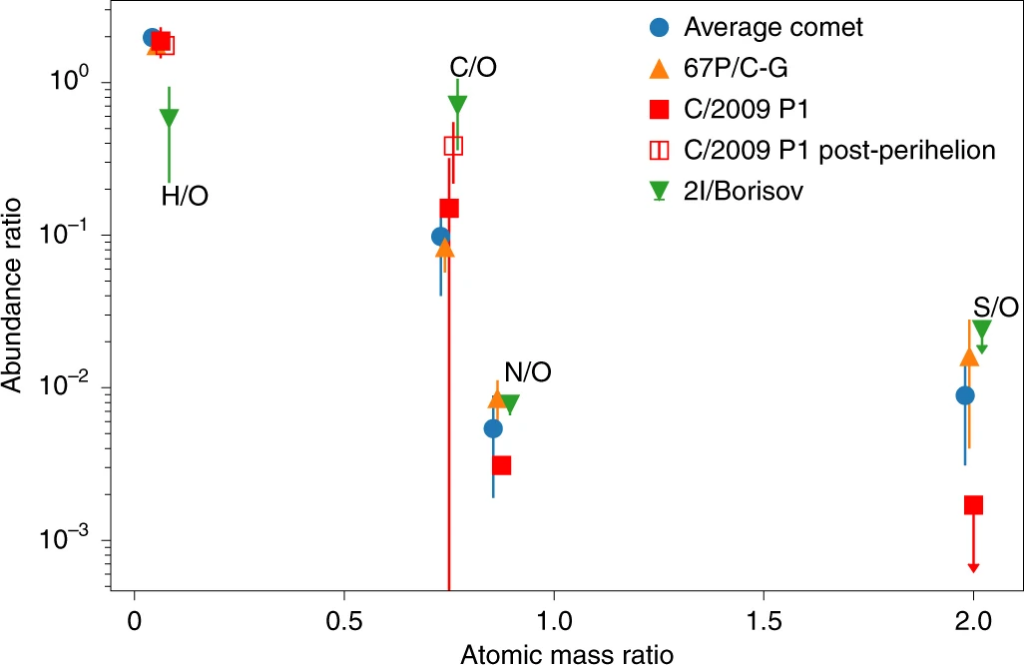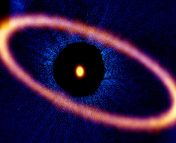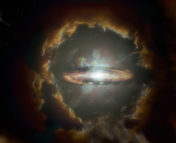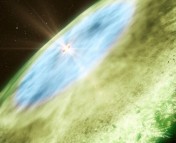Title: The carbon monoxide-rich interstellar comet 2I/Borisov
Authors: D. Bodewits, J. W. Noonan, P. D. Feldman, M. T. Bannister, D. Farnocchia, W. M. Harris, J.-Y. Li, K. E. Mandt, J. Wm. Parker & Z.-X. Xing
First Author’s Institution: Department of Physics, Leach Science Center, Auburn University, Auburn, AL, USA
Status: Published in Nature Astronomy [closed access]
AND
Title: Unusually high CO abundance of the first active interstellar comet
Authors: M. A. Cordiner, S. N. Milam, N. Biver, D. Bockelée-Morvan, N. X. Roth, E. A. Bergin, E. Jehin, A. J. Remijan, S. B. Charnley, M. J. Mumma, J. Boissier, J. Crovisier, L. Paganini, Y.-J. Kuan & D. C. Lis
First author’s institution: Solar System Exploration Division, NASA Goddard Space Flight Center, Greenbelt, MD, USA & Department of Physics, Catholic University of America, Washington DC, USA
Status: Published in Nature Astronomy [closed access]
This bite describes two papers that were published in the same issue of Nature Astronomy and concern complementary composition measurements of the interstellar comet 2I/Borisov
A first of its kind object
Comet 2I/Borisov (the ‘I’ stands for interstellar and ‘2’ denotes that it’s the second such object to be discovered) was detected on 2019 August 30 by amateur astronomer G. Borisov (using a 0.65-meter telescope he designed and built himself!). Its trajectory through our solar system and a hyperbolic orbit clearly tell us that it’s coming from outside the solar system. 2I/Borisov is the second interstellar interloper to our solar system, after 1I/’Oumuamua. But unlike 1I/’Oumuamua, 2I/Borisov was observed to be actively outgassing material (when passing close to the Sun, a comet warms and begins to release gases) and hence labelled as the first interstellar comet. 1I/’Oumuamua on the other hand was discovered (back in October 2017) when it was already leaving the Solar System, making detailed studies difficult. Specifically, there were no gas spectroscopic detections made for 1I/’Oumuamua. 2I/Borisov on the other hand, which has looked a lot like comets in our solar system with dust and volatile gases blowing off it, provided opportunities for astronomers to learn about its chemical composition.
The discoveries
Comets spend most of their lives at large distances from any star, during which time their interior compositions remain relatively unaltered. Cometary observations can therefore provide direct insight into the chemistry that occurred during their birth at the time of planet formation. In the case of 2I/Borisov, it provides an opportunity to probe the primordial composition of an entirely different stellar system. 2I/Borisov was observed by two premier astronomical observatories, the Hubble Space Telescope (HST) and the Atacama Large Millimeter/submillimeter Array (ALMA), in the Fall/Winter of 2019, when the comet was near the perihelion of its trajectory around our Sun and hence its outgassing activity due to heating was highest. While HST observed the comet in the UV using its Cosmic Origins Spectrograph (COS), ALMA observed it in the millimeter wavelength range. The goal was to look for spectroscopic evidence for a suite of molecules commonly found in solar system comets, like H2O, CO, HCN, etc. and understand their relative amounts in this comet, which helps placing it in context of our solar system comets.
While most of 2I/Borisov’s properties are similar to solar system comets, the result that stood out from the HST and ALMA observations and their subsequent analysis was the concentration of carbon monoxide or CO. Both HST and ALMA detected strong spectral emission lines of CO, whose strengths were used to deduce the amount of CO outgassing from the comet. The results show an extraordinarily high abundance ratio of CO to H2O of around 35-155%, much higher than the average value of 4% in comets of our solar system (Figure 1). Even Oort Cloud comets, which come from a much colder and volatile gas rich part of the outer solar system, only have CO/H2O ratios in the range 10% to 24% (Figure 2). This makes 2I/Borisov one of the most CO-rich comets ever observed.


What does this tell us about the comet
2I/Borisov’s large wealth of CO implies that it came from a planet formation region that has very different chemical properties than the disk from which our solar system formed. Many of the protoplanetary disks that have been observed by ALMA extend well beyond the distance (with respect to their host stars) where our own comets are believed to have formed. The outer reaches of these extensive disks are extremely cold, which means that a highly volatile gas has like CO can be found in large amounts. It is possible that 2I/Borisov came from a system with one of these larger disks. The HST team considers a carbon-rich disk around a cool red dwarf star as one possibility for 2I/Borisov’s birthplace. These stars have the low temperatures and luminosities where a comet could form with the type of composition found in comet Borisov, and gravitational interactions with a planet orbiting in the outer reaches of the system could have ejected the comet. In fact, the authors note that dynamical models of our solar system have predicted that large numbers of the comets in our Oort Cloud could be interstellar interlopers.
The two interstellar objects, 1I/’Oumuamua and 2I/Borisov, have in some way ushered an entirely new area of exoplanetology – the study of debris from other stellar systems. We expect to find more interstellar visitors in the near future with next-generation survey telescopes like the Vera C. Rubin Observatory, and perhaps study them up close with ambitious missions like the Comet Interceptor.




